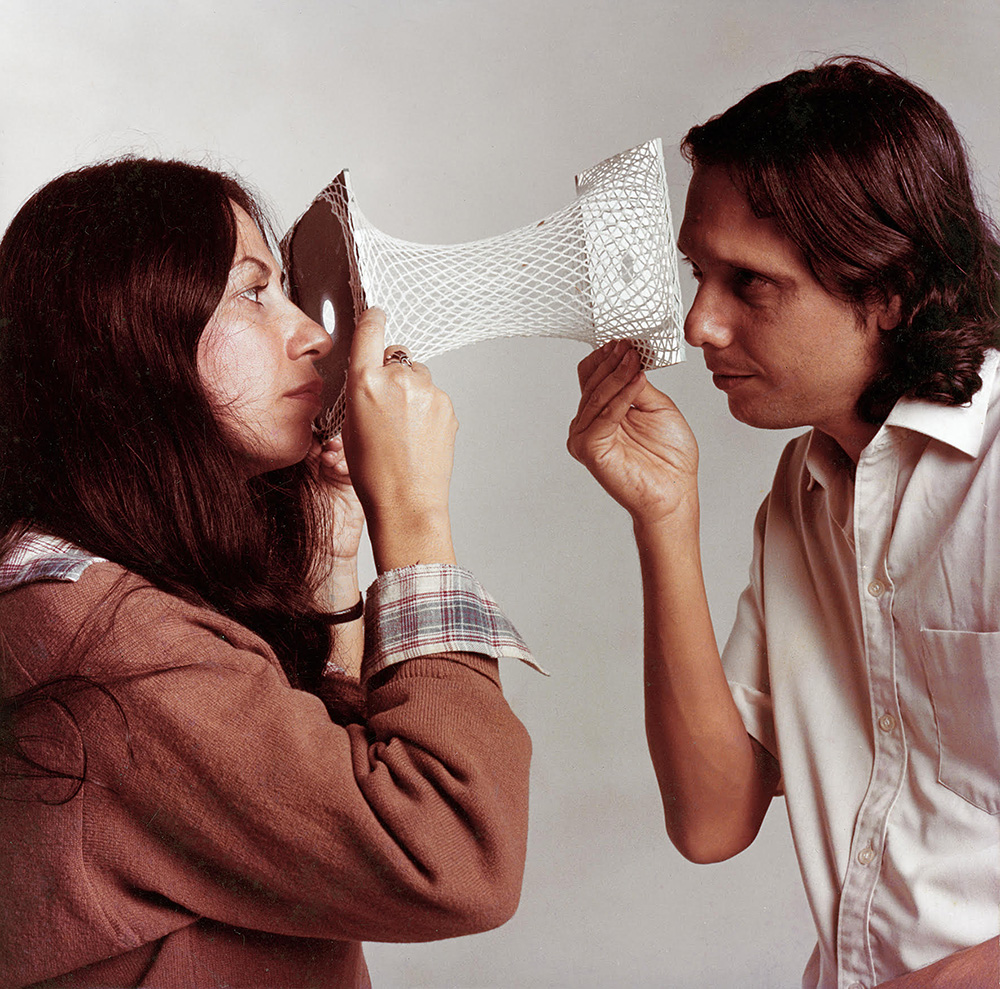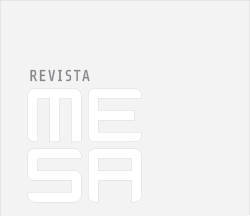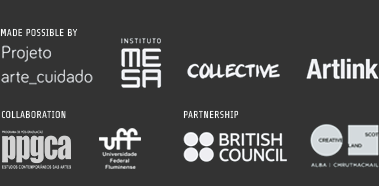
Lula Wanderley. Diálogos da projeção do olhar (Dialogue on the Projection of the Gaze): Lula Wanderley with Gina Ferreira. Objects and photography, c.1984.
“…There is a hidden physiognomy in sugar cane: As in a beating clock there is a possible melody:1
Understanding Lygia Clark’s Relational Objects
Lula Wanderley
At the beginning of her experiences with Relational Objects (1970), Lygia Clark had been immersed in a cultural environment permeated by psychoanalytic language: it was a time where it was difficult to think of contemporary man without the presence of the psychoanalytic gaze. Lacanian language, now dominant and demarcating, was at the time still nascent. The limits of psychoanalysis were being tested and extended at every instant, principally through a few authors who emphasized the question of the body, drawing on Freud’s ideas about the organic as the place from which the psyche unbinds itself. At that time it was common to parallel Lygia Clark to the pediatrician and psychoanalyst Donald Winnicot even by the sonority of the name of the objects/concepts created by the two: Relational Object / Transitional Object. With the transitional object, Winnicot describes, in the universe of the baby’s creative interactions with reality, the creation of a hybrid object that at the same time is offered by the mother, and, simultaneously is a creation of the baby. A break in the boundary between subjectivity and objectivity that brings the materiality of affects closer. Lygia’s Relational Object, at the same time that is perceived by the body, is reconstructed as body. Like with the Winnicotian object, the dichotomies with which we organize our everyday life – time / space, metaphoric, and physical – are obliterated. The phenomenology of the perception / creation of the object is what brings Lygia close to Winnicot; but not more than that. Winnicot continued in his expansion of Freud’s concept of “drives,” Lygia journeyed into the unknown.
In the 80s, a psychoanalyst close to Lygia saw the Estruturação do self [Structuring of the Self] as a kind of “pre-psychoanalysis”, since it did not address the historical dimension of the subject, which is where psychoanalysis inserts itself. Analysts would send clients to Lygia for an “unlocking” when the psychoanalytic process was not advancing. The credibility of Lygia’s work was that it supported such referrals. Lygia Clark believed that Relational Objects were much more; in a room in her apartment, which she affectionately called her “consulting room”, she daringly assumed her own position by defining the Estruturação do self as a “therapeutic process in itself.” It is only later, when we had access to her “clinical diary” that we became aware of her courage/daring to dive into the expression of the grave conflicts of a generation that were seeking a full and stable life in the face of the sudden changes in social values that characterized the time.
Feeling isolated, Lygia took me on as her interlocutor, inviting me to work with her on the Estructuração do self. Soon I discovered that the Relational Objects compose a language directed to the body and only to it, and that I could, within the parameters of that language, create other objects; propose other rituals for the body; to seek another “public” – to walk in ways that Lygia did not know. Lygia’s work is not just to be reproduced, it is to be expanded upon.
At the time, some Relational Objects, scattered in my studio, attracted the attention of a young man in suffering from severe catatonic schizophrenia. Engaging his interest via playful touch on his body, I could perceive the potentiality of using these objects to dialogue with people whose bodies had been seriously attacked. I extended my work beyond a clinical practice geared toward existential middle-class crises to reach out to public psychiatric hospitals in poor/peripheral neighborhoods of Rio de Janeiro. Estruturação do self has become an instrument of an ideological political struggle against the existence of these insane ghettos with their inhuman treatments. It was one of the instruments that served me as a guide to enter and transform those insane places.
Ever since I began working in this field, I have been fascinated by the way in which people with serious de-structuring of the body and language take the Objects created by Lygia as something intimate and familiar; they seem not to distinguish them from the objects of everyday life. Their bodies seem to be open to everything (full and empty of everything) capable of perceiving the imperceptible movements of the world. I dare say that the “crazy ones” were the public that most understood Lygia Clark. And what most fascinates is the indecipherable fluidity and extensibility of the Relational Objects that enables an immediate opening up to the other. A process that is capable of attaining almost inaccessible / indefinable experiences and find in them meaning. Perceived and worked by the body, the Relational Object travels between experiences that are linguistically less organized and constructions of symbolic intensity.
One of the most exacting resources that I have found for understanding Estruturação do self is based on the study of Lygia Clark’s trajectory itself. Albeit with singularity: that it involves reversing the chronological direction. To deconstruct an experience of Estruturação do self is to discover traces of previous proposals and the concepts associated with it. Only then it is possible to establish dialogues with theoretical predilections.
Clara was twenty-two when she came to me. A very close friend, one with whom she had a secret passion, had been killed, probably by the repressive forces of the military dictatorship. And she couldn’t tolerate the violence of his death and absence of factual clarity and ended up “going crazy.”
I initiated a process of touch with the Relational Objects at a time when Clara’s intense suffering had settled a little. In the beginning, the description of cuts in the body was common in Clara. They were cuts or holes, mainly in the thorax, where the Objects functioned like “the bandages of a curative.”
Then one day, however, Clara gave a cry of despair and begged me to stop. She told me that the Objects I placed on her body had disappeared and this was causing an unbearable vertigo of emptiness. This ended up happening several times, but after a while no longer bothered her, rather it now seemed like a natural condition. Sometimes she tried to perceive my presence in the room instead of the Object, so that the agony would cease. To my surprise this “natural condition” reversed itself. Now the Objects that had disappeared in contact with her body ended up reappearing at undetermined moments, bringing with them the anguished vertigo of emptiness. The fusion body / object / environment seemed, paradoxically, to reconstruct the “I”.
The description of cut / holes in the body; of the absence and presence of the Object and its relation to the agonizing anguish, compose the conflicts of the transition from the Object to a new dialectic with the body where the boundaries we live as “real” are extinguished (subject-object, interior-exterior, time-space) – we accept the paradox. Lygia, in order to explain this new condition of the Object created the myth of the Baba Antropofágica [Anthropophagic Baba or drool]: a saliva that flows uninterrupted from our mouth binding us to the world. The drool is a thread of life that expands, to break it means shattering our own body – psychic suffering as a metaphor for death. The process of Estruturação do self is to relive our permanent quest to reconstruct the self. Clark outlines this when she says “I appear as a possibility that slides on the edges of the individual and the collective without being defined by any of these categories – life as the expansion of all beginnings.2 In abandoning psychoanalytic nomenclature Lygia Clark replaced the absence of a theory with the minute annotations of all of her therapeutic experiences seeking meaning for the Estruturação do self through thoughtful literary constructions of poetic density. Thus, she preserves the Object in its origin and amplifies it, for Estruturação do self, the possibility of new experiences – new theoretical affinities.
The particular sensoriality of the Objects that requires the body’s work to perceive / represent it, brings to the body an autonomy – an “organicity” – of a kind very different from that problematized by other artists of the time period. Fluidity and extensibility, the expression of this autonomy, is what allows it to have meaning for our experience, even amidst feelings that are incomplete/imperceptible to our consciousness. This is what defines it and makes it difficult to be captured and diluted within theoretical discourse – its capture will always be partial. In the tension of frontiers, the Objects are always beyond where we seek to find them, which bring us much closer to the paradoxes of art. Lygia, in her time period, could be seen as contemporary to the recent studies about the world of imperceptible exchanges that exist between us involving the body, affects, perception of the world, and the structuring of the self.3 In trying to overcome the subject/object relation, Lygia opens up the body to interior imaginary space where the metaphysics of her work happens. Here, all the processes from the perception of the world to the creation of meaning and significance gain another reading, principally via the proximity of materiality and affects. This brings Lygia close to: contemporary studies on perception and on lived memory in neuroscience; the psychology that emerges from the thinking about the communication of the unconscious and the body in José Gil; and to the psychoanalyst Pierre Fedida’s concepts of transference and listening to the body etc.
“They see everything simultaneously from the inside and the outside,” with this observation on the participants of the art workshops of the Museum of Images of the Unconscious, the critic Mário Pedrosa describes the sensory excitability of schizophrenics that makes them able to perceive the hidden physiognomy of forms.4 The exterior (the perceived object) in an indivisible continuum unites with the interior – the object constructed by our emotions and feeling. The expressiveness of the formal dynamics of objects defines our emotions as much as they do and vice versa. For Mário this physiognomic world is the event that takes place in the artistic phenomenon, a state that does not differ from the perception of any type of object when, on some occasions, we are freed from the urgencies of everyday practical life. Mário thus traces the “Moebius strip” that Lygia Clark later would cut in her piece Caminhando [Walking] 1963: every object of art is a relational object.
Let’s leave visuality and return to the organic arachnid world of Lygia Clark. Clara’s experiences with the Relational Object, in their play of proximity / absence, distance / presence, totally fits, in their similarity, albeit in another plane of perception, into that phrase of Mário Pedrosa. Clara perceives the Object, simultaneously, inside and out. Her body, capable of perceiving the slightest vibrations of the world, opens itself to an object bare of any meaning, even if this removes any vestige of visuality – just as the word was banished in the art of forms and formations. The object reduced to bundles of sensations touches a body / experience imprecisely, “erased” by suffering. The object reconstructs the body that in turn reconstructs the object into an indivisible continuum between materiality and affect. This arachnid expansion (anthropophagic baba), whose subjectivity occurs in an imaginary interior of the body is a striking creative / poetic force. If, as Mário Pedrosa leads us to think: perceiving is a creative action on reality (perceiving is creating), the touch of Relational Objects brings creativity to our most archaic experience of constructing ourselves in the face of voids in the soul and suffering. A structuring experience that is an expansion of beginnings – one that is therapeutic because it is art.
Lygia Clark’s work is its own journey and along it each proposal contains its origin and future. The Estructuração do self is a synthesis of all of this journey. And if Estructuração got close, in its own time period, to future knowledge, it is there that it arrives at its most remote origin.
This text is part of the introduction to a book I am currently working on that brings together reflections and narratives from over thirty years of clinical and artistic practice.
***
Lula Wanderley
Lula is an artist, born in Pernambuco, who has lived in Rio de Janeiro since 1976. In Recife he worked as a graphic artist in newspapers and magazines and experimented with visual poetry. Simultaneously, he studied medicine graduated from the Federal University of Pernambuco. In Rio, he collaborated with Nise da Silveira at the Casa das Palmeiras, and with her and Mario Pedrosa on the project to reformulate the Museum of Images of the Unconscious, sponsored by FINEP. He has held individual exhibitions, among them A estratégia angular de um poema (CMAHO, curator Izabela Pucu, 2016) and participated in various collective exhibitions such as the recent Lugares do delírio curated by Tania Rivera. He also collaborated with Lygia Clark on research on art / body / psychism. He created EAT, of which he is technical coordinator, where he has been working with psychotic patients for 25 years, having as main goal the search for an experimental and poetic clinical practice.
________
1Line from a poem by João Cabral de Mello “O vento no Carnaval” (The Wind at Carnival) published in Duas águas: poemas reunidos, 1956. In: João Cabal de Melo Neto. Obra completa, ed. Marly de Oliveira. Rio de Janeiro: Nova Aguilar, 1994, 150-151. Free translation.
2With the myth of Baba Antropofágica, Lygia puts herself in an arachnid position: we weave an organic network that connects us to the world. This brings her closer to the poet and educator Fernand Deligny and his arachnid propositions (outside of the language) of collective constructions in his work with the autistic. Those with theoretical predilections find close parallels with Deligny as well as other points in common, such as similarities with Winnicott. It is interesting that prior to this parallel being made, in a letter to Mário Pedrosa, Lygia imagined herself as a scorpion: an animal that was also of laceratingly organic constructions.
3 The accompanying catalogue to exhibition Lygia Clark: Arquivo para uma Obra-Acontecimento: Projeto de ativação da memória corporal de uma trajetória artística e seu contexto (Archive for a Work-Happening: Body Memory Activation Project of an Artistic Trajectory and its Context) features a series of interviews with diverse artists, therapists, critics and patients of Lygia Clark edited by Suely Rolnik and published by SESC São Paulo in 2011 is an excellent example of this parallel.
4 At the end of the seventies, I asked Mário Pedrosa to suggest some articles that might help me understand Lygia Clark. Mário lent me his typewritten thesis, corrected by hand. At this time, I underlined two sentences to try to understand them on another occasion. One of the sentences was: “They perceive the object from the inside and outside.” [E.N. This phrase comes from one of Pedrosa’s studies called “Form and Personality” from 1950s published in Mário Pedrosa. Arte, forma e personalidade: 3 estudos. São Paulo: EdUsp, 1979]. Later, I found this phrase again in a beautiful article by Kaira Cabañas about Mário. Kaira’s article motivated me to write this text. [E.N. The article Lula is referring to was originally published in English in October, Kaira M. Cabañas, “Learning from Madness: Mário Pedrosa and the Physiognomic Gestalt,” October no.153, Summer 2015, 42-64. Her book expanding on this theme, Learning from Madness, has just been published by University of Chicago Press, 2018.]



